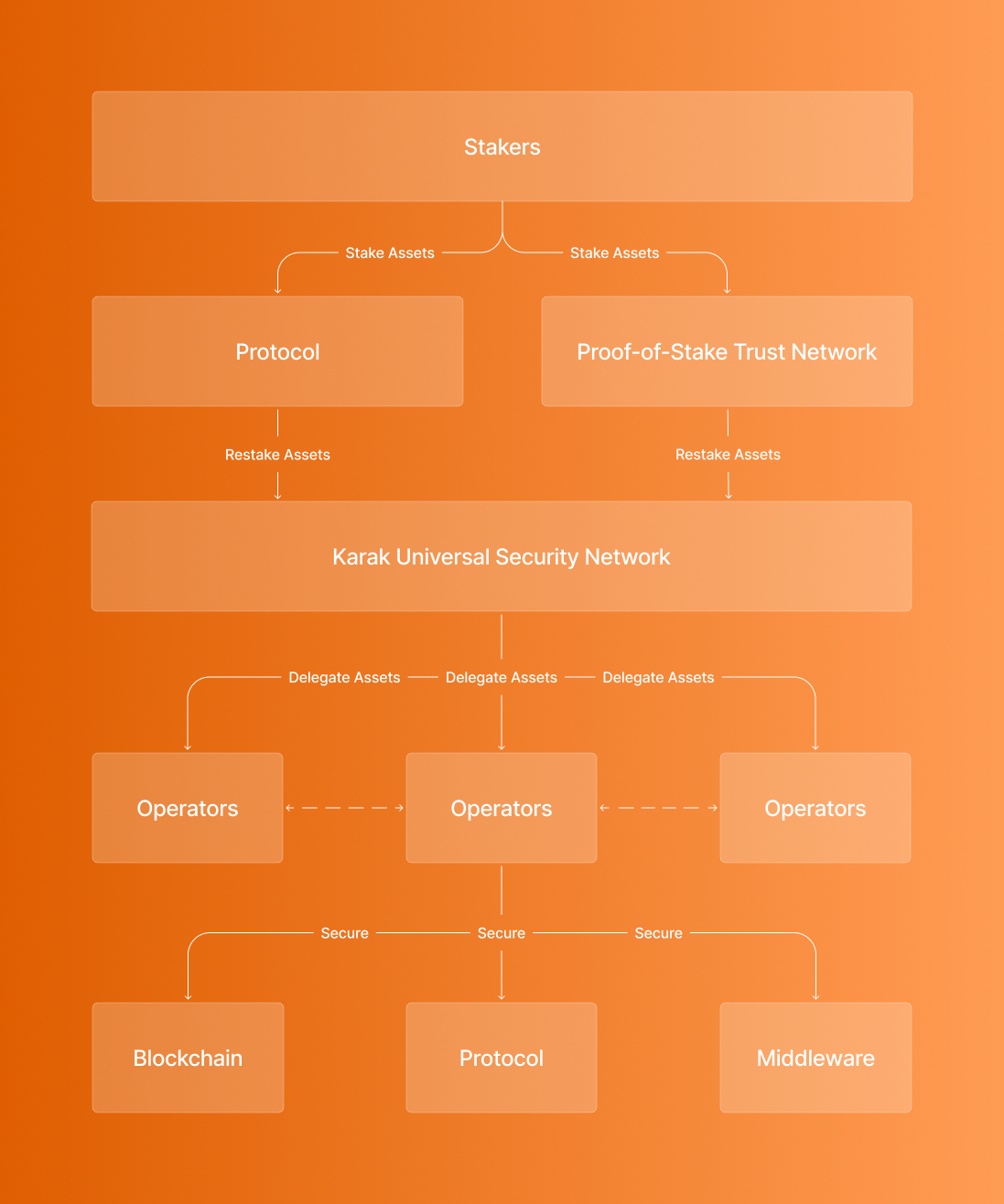Karak Overview

What is Karak?
Karak is the global base layer for nation states, enabling them to create secure, specialized blockchain networks, optimized for internet markets.
Karak is building a novel architecture for nation states to create secure, specialized blockchain networks, optimized for internet markets. Finance is the bedrock of every nation, and attracting foreign investment and capital inflows is critical to fueling economic growth and prosperity. Karak enables nation states to bring entire financial markets onchain, connecting stocks, bonds, options, derivatives, and other financial instruments to global markets.
The Karak Network Stack (KNS) is the most flexible, secure, and performant architecture that allows fullstack customizability. It enables the rapid creation of blockchain networks with no inflation by leveraging shared security and instant, robust validator sets to ensure censorship resistance, liveness, and proper network operations. This solution not only allows nation states, but anyone, to create specialized blockchain networks, initially optimized for internet markets, but also extensible to other financial, AI, and consumer applications.
How does Karak work?
Karak enables users to repurpose their staked assets to extend Ethereum as well as other trust networks' security to other applications.
Stakers can allocate their assets to a Distributed Secure Service (DSS) on the Karak network and agree to grant additional enforcement rights to their staked assets. The opt-in feature creates additional slashing conditions to meet the conditions of secured services such as data availability protocols, bridges, or oracles. The slashing conditions enforce participant integrity and ensure the security of the applications utilizing Karak is upheld.
Karak operates as a marketplace where developers get to incentivize validators to allocate their restaked assets to secure their secured services. This is a step-improvement to applications having to issue their own highly inflationary tokens as rewards for validators and having to establish a new trust network from the ground up. With Karak, developers can make it attractive for validators to choose their projects through simple, non-dilutive incentives. This significantly reduces the financial and temporal investment required compared to building a new trust network from scratch.
Furthermore, Karak's universal restaking facilitates enhanced bootstrapping and composability across various networks. Despite the varying staking parameters of different blockchains, introducing a multi-asset restaking approach can help standardize these capital requirements.

How is Karak different?
Multiasset restaking: Karak introduces multiasset restaking, a new primitive in cryptoeconomic security allowing users to restake assets such as ethereum, liquid staking tokens, stablecoins, and more to earn rewards. In Karak, restakers have the ability to provide a basket of assets to a DSS, or a Distributed Secure Service, preventing a single asset's failure from compromising a DSS. This flexibility allows DSS to become economically self-sustaining without having to issue highly inflationary awards.
Restake anywhere: Karak enables developers to focus more on innovation and building products wherever their users are instead of where the infrastructure is available. Currently, developers have to use complex, unsafe, and expensive message bridges to access restaking infrastructure beyond Ethereum mainnet. However, most applications and users aren't on Ethereum L1, they are on L2s, sidechains, and in some cases other blockchains entirely. Karak's unopinionated design enables every chain to have restaking infrastructure natively deployed and secured with its own set of assets.
Turnkey development: Karak enables developers to easily iterate and deploy new, unique services secured by a robust and secure trust network on day one. Karak's suite of tools and SDKs allow existing dApp developers to extend or create new functionality for their applications with ease. Karak's K2 network enables cutting-edge DSS's to experiment with custom precompiles and a steady pool of restaking capital.
Ecosystem Overview
Karak’s architecture consists of several key components.
Restakers
Restakers contribute to universal security across Ethereum and other blockchains in exchange for rewards.
Distributed Secure Services (DSS)
Distributed Secure Services utilize the restaked assets to enhance security while reducing operational expenses.
Example: Several Distributed Secure Services will be unveiled in the coming weeks, including core services incubated by Karak contributors.
Chains
Chains or rollups leverage the services rendered by distributed secure services.
Example: K2 is a risk management L2 currently built on top of Karak that will leverage services provided by distributed secure services. As performing operations and activities on the L1 can be prohibitively expensive for both developers and users, K2 will also serve as the de facto sandbox for all DSS's to develop, test, and launch mission-critical protocol upgrades before having to enshrine services on the L1. Moreover, by adding custom precompiles that enable even more validators to validate DSS's, K2 is providing the infrastructure that will allow for services to become more decentralized than ever before.
Operators
Operators, whether an individual or an organization, perform essential validation and security for distributed secure services.

Restaking Methods
For now, users can participate in restaking through several methods, including:
-
Liquid Staking/Restaking: Users have the option to restake by depositing their Liquid Staking Tokens (LSTs) or Liquid Restaking Tokens (LRTs) into Karak smart contracts. Validators can take LSTs or LRTs that have already been staked in protocols like Lido, Rocket Pool, Mantle, and Etherfi and restake these assets on Karak.
-
Stablecoins: Another novel method is giving users the ability to restake by depositing their stablecoins into Karak smart contracts. Validators can take stablecoins that have already been staked in protocols like sDAI and restake these assets on Karak. The advantage of stablecoins for restaking is that the lack of volatility makes it easier for a DSS creator to forecast the amount of economic security they can offer.